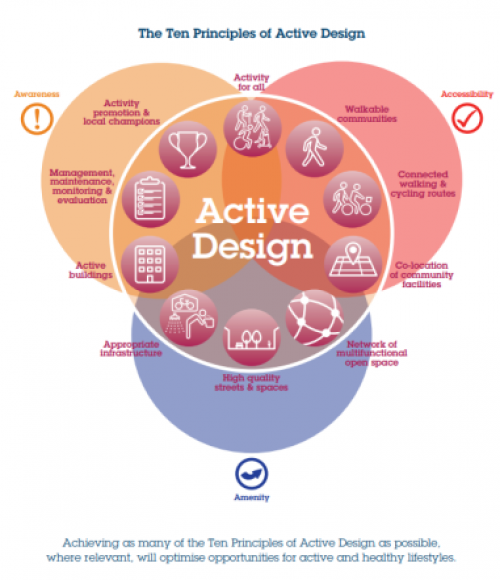Planning for Rutland’s Future - Issues and Options Consultation
Issue 8: Ensuring new development is well designed and encourages active and healthy lifestyles
Strategic Objective 8: Ensuring new development and open spaces support health and wellbeing and encourage active and healthy lifestyles.
The environment in which people live can impact on both their physical and mental health and wellbeing. The design of neighbourhoods, homes, places of work, streets and opens spaces can support the health and wellbeing of people by enabling healthier lifestyles. It can do this by creating environments and places that reduce health inequalities, promote social interaction and respond to the needs of all ages both within the new development site and surrounding area. Designing places where people can be active, have places to meet and play, seek to design out crime and ensuring that appropriate community and fire safety design considerations are incorporated within new development schemes will contribute to towards the long-term sustainability and resilience of developments.
Whilst the overall health of Rutland's population is better than the national average there are significant underlying long term health issues and increasing levels of inactivity. The population of Rutland is older than the national average and is projected to continue ageing. There are hidden pockets of deprivation and a large proportion of residents living in rural areas which pose challenges in terms of health and services provision.
The NPPF requires health and wellbeing to be addressed in local planning policy. Paragraph 92 sets out that planning policies and decisions should aim to achieve healthy, inclusive, and safe places which enable and support healthy lifestyles, especially where this would address identified local health and wellbeing needs. Examples for how this can be achieved include the provision of safe and accessible green infrastructure, sports facilities, local shops, access to healthier food, allotments and layouts that encourage walking and cycling.
Locally, there is a role the Local Plan can play to support delivery of the strategic priorities outlined within the Rutland Joint Health & Wellbeing Strategy: The Rutland Place based Plan 2022 - 2027. The overall vision is to nurture 'safe, healthy and caring communities in which people start well and thrive together throughout their lives', with the essence of the strategy's goal being 'people living well in active communities'. It is therefore crucial the Local Plan aligns and contributes towards achieving the strategic priorities by maximising the opportunity to develop physical environments enabling and encouraging healthy living.

Figure 4: Principles of Active Design
Best practise and guidance for planning healthy places is set out in 'Building for a healthy Life' and Sport England's Active Design. The National Design Guide sets out further detail on promoting social interaction through inclusive design.
The Council has adopted a Design Guide Supplementary Planning Document (SPD); the key aims of this Design SPD are to:
- Establish the expectations for a high level of design and build quality in all development proposals in Rutland;
- Set out the design steps and considerations that planning applicants are expected to undertake; and
- Provide applicants with a clear understanding of good quality design at any scale or type of development, from a new community to an individual home extension.
Health and wellbeing should be considered at the earliest opportunity in the design of new development proposals to ensure health improvement recommendations can be implemented. The Council will need to consider how the new Local Plan can best integrate this to increase the range of long-term benefits to residents. The Local Plan will need to ensure that these principles are integrated into the design policy and promote the use of the Rutland Design Guidelines SPD.
Undertaking a Health Impact Assessment (HIA) as part of the plan making process will ensure this. A HIA is a practical way to identify and assess the effects a proposal may have on the health and wellbeing of different groups of people. Undertaking a HIA in relation to the development plan can help judge the likely health impacts of that proposal , covering healthcare, health behaviours, social, economic and environment factors. Social, economic and environmental factors contribute approximately 50% of what makes us healthy. The completion of a HIA will help ensure any positive health impacts are achieved and negative health impacts minimised.
Question 41 Options for Health and Wellbeing
Which option(s) do you consider to be most appropriate to include in the Rutland Local Plan?
Option A: Require new development to demonstrate how health and wellbeing principles are incorporated within the proposal
Option B: Require a Health Impact Assessments to be provided by applicants for specific development, depending on the scale and type of proposal.
Question 42 Health Impact Assessment
What factors (including scale and type of development) should be considered when deciding whether a Health Impact Assessment is required?
Question 43 Design
Which option do you consider to be most appropriate to include in the Rutland Local Plan?
Option A: Reference the Rutland Design Guide Supplementary Planning Document (SPD) in design policies to provide clear guidance in how to achieve high standards of design and build quality.
The SPD will be used to provide design guidance for a wide range of design related issues including those that could enhance the health and wellbeing of the future community of new developments and create places that are resilient to climate change.
Option B: Include more detailed design requirements in the design policy.
Going beyond the current policy approach, additional design requirements could be set out for specific policy areas and additional design criteria could be included for large developments. Policy will specify that 'Building for a healthy Life' will be used to assess the design of new development.
Question 44
Do you have any additional suggestions or comments about how the Local Plan can help to ensure that new development is well designed and encourages active and healthy lifestyles ?
